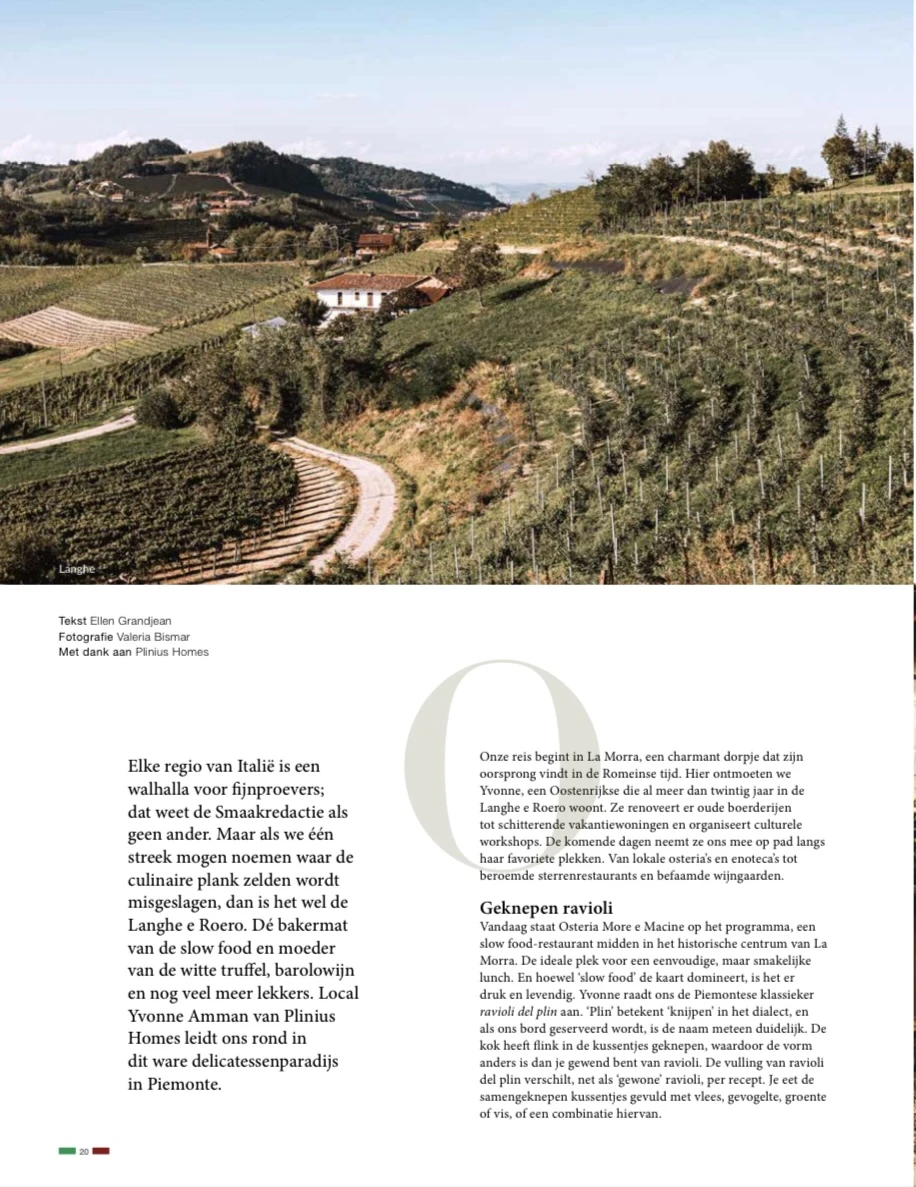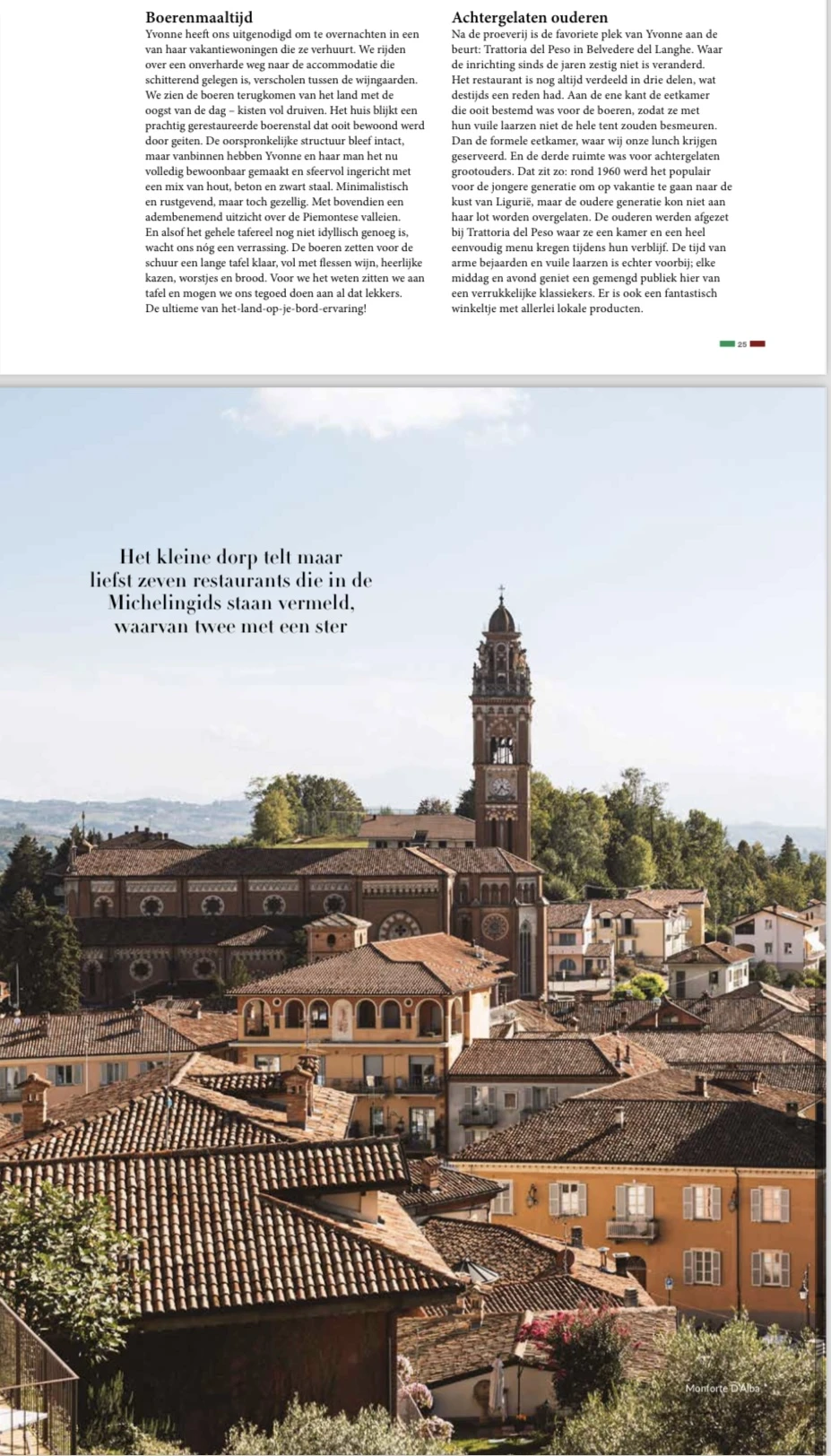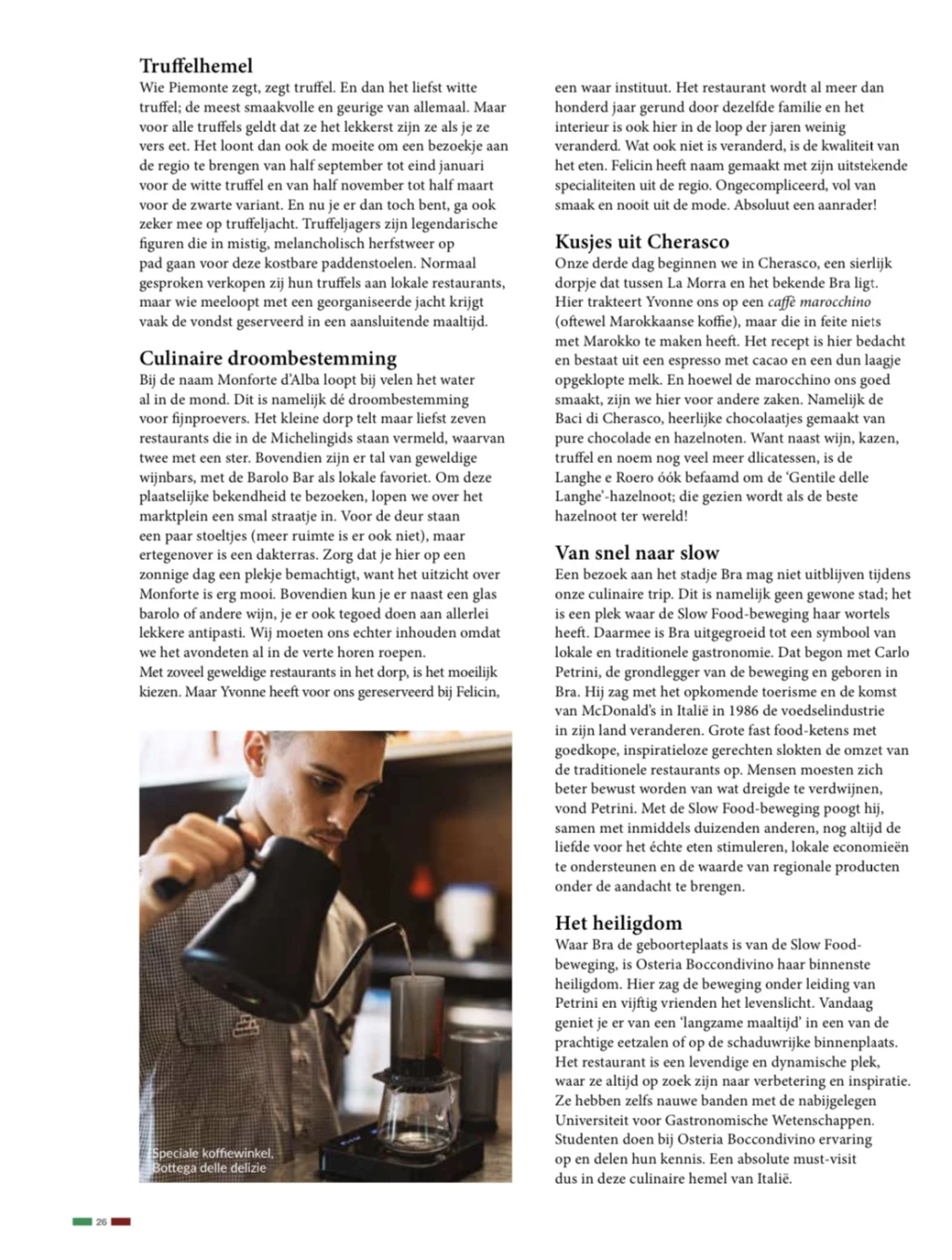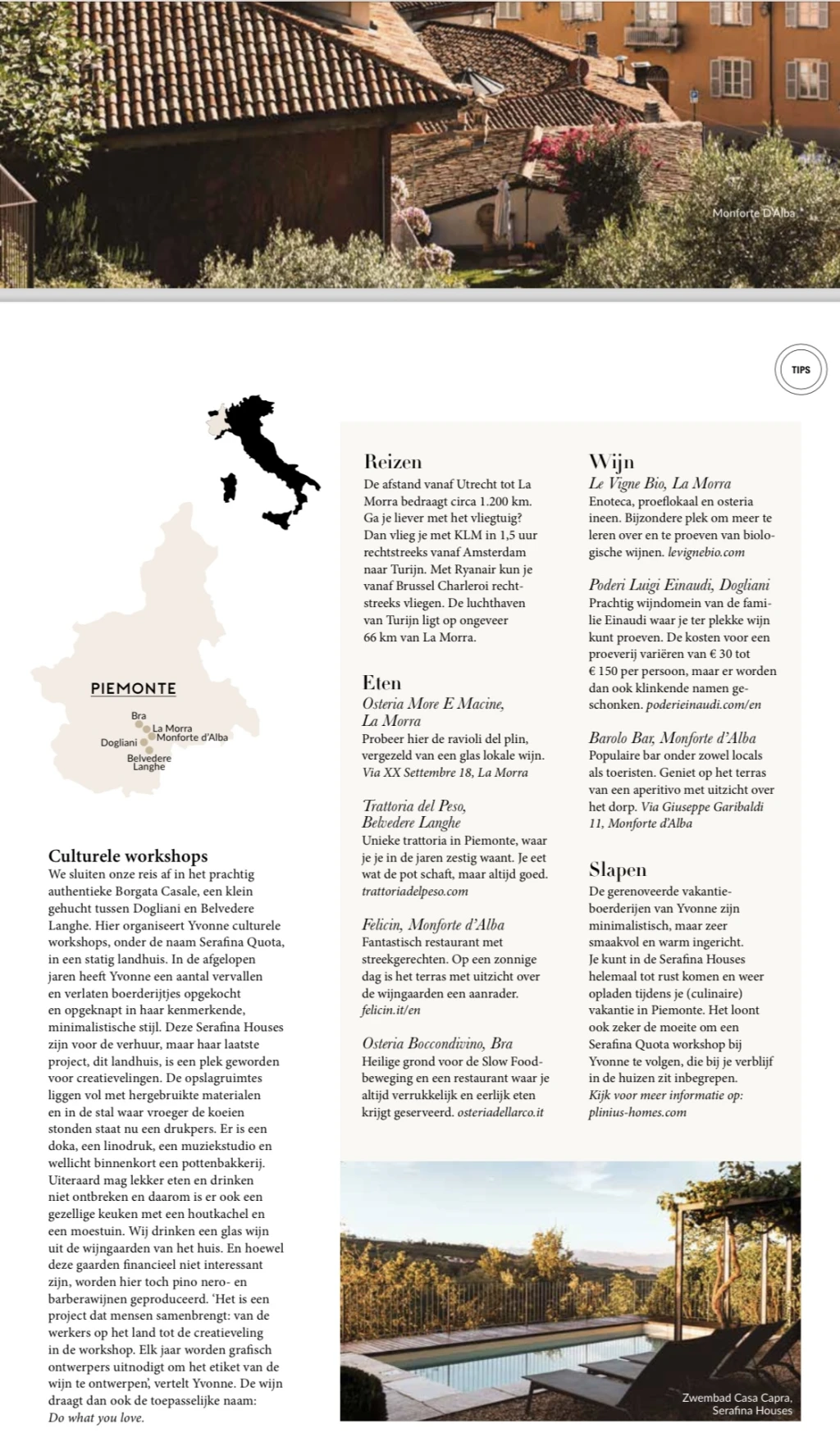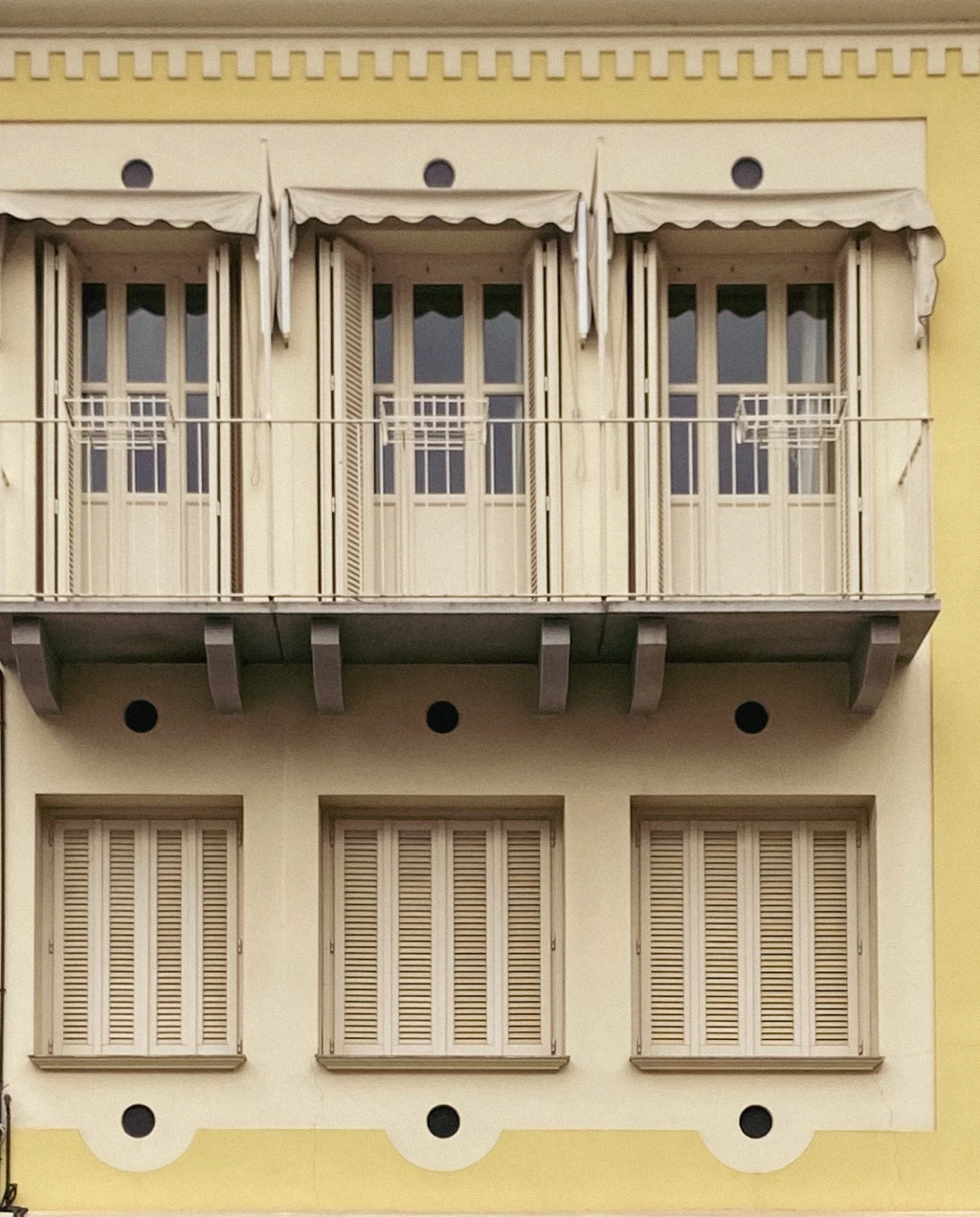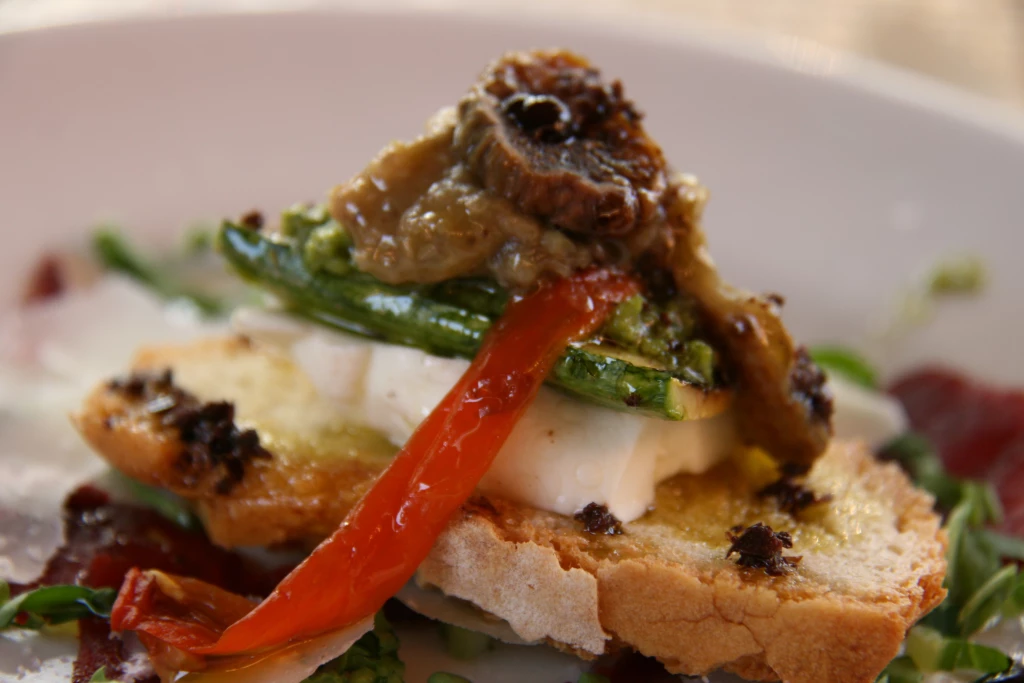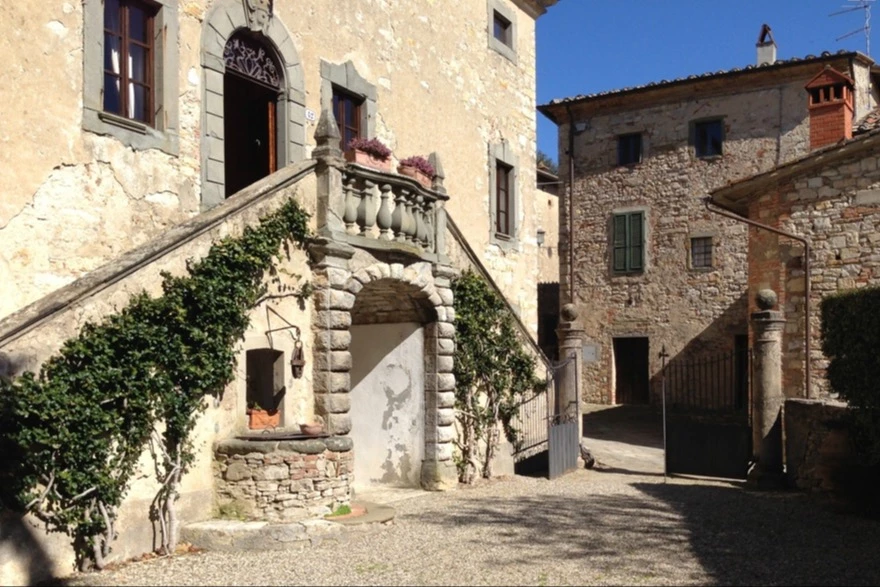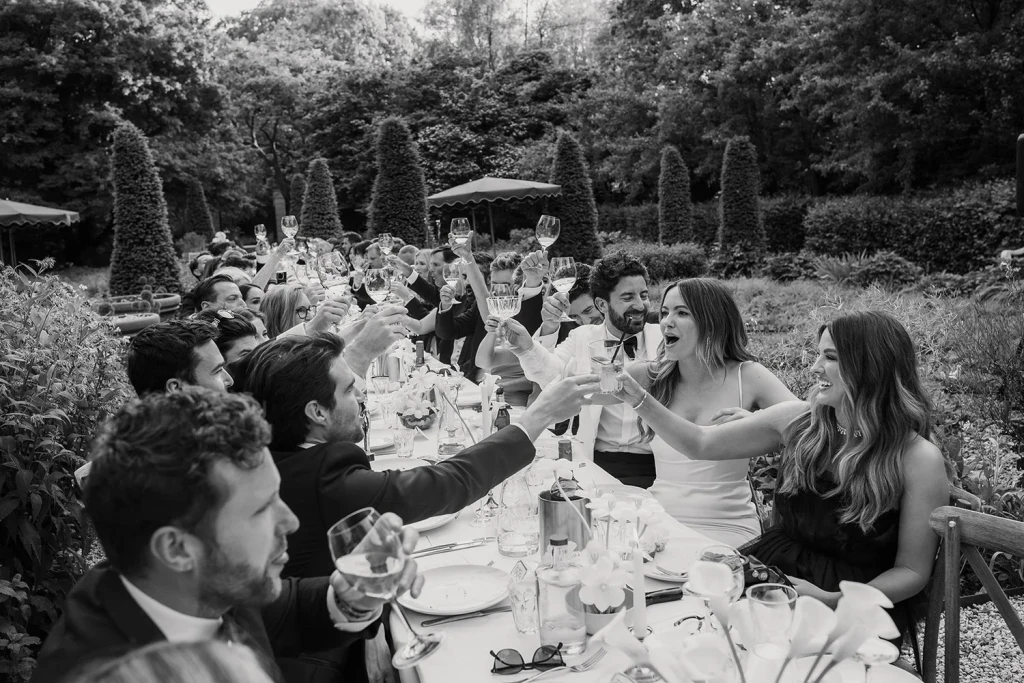Taste Piemonte
Together with Yvonne Amman, Plinius, photographer Valeria Bismar, and Dutch Magazine “de Smaak van Italie”, we traveled through the delicious region of Piemonte; a culinary tour through Le Langhe Roere. You can read the original article by buying the magazine online at The Taste of Italy/ De Smaak van Italie
A Delicious Tour Through le Langhe e Roero
UNESCO-protected, with rolling countryside and snow-capped mountains on the horizon, Piedmont is Italy's unsung hero. The region is peppered with fantastic wineries and Michelin-starred restaurants and is rich in truffles. Plus, a new clutch of stylish hotels is visiting even more compelling - especially in autumn, when its landscape transforms into a riot of ambers and reds. Here's where to stay, eat and play.
La Mora
Our journey began in La Mora, a charming village dating back to the Roman era, surrounded by breathtaking vineyards. Long recognized as a prominent wine-growing region, La Morra once had strict laws in place to protect the Nebbiolo vine. Cutting down a Nebbiolo vine was considered illegal, with penalties ranging from fines to severe measures like amputation or hanging. Fortunately, such draconian practices are confined to the past, and La Mora has transformed into a destination to relish exceptional wines, delectable cuisine, and captivating architecture.
What makes the Nebbiolo vine so valuable? The Nebbiolo (Nebby-oh-low) is revered as the Queen of grapes. It stands as the oldest native red grapevine of Piedmont and one of Italy's most noble and prestigious varieties. Its name is derived from ‘nebbia,’ the Italian word for mist or fog. The enigmatic morning fog, a common sight in this region, holds significant importance for the Nebbiolo grape. Being a demanding vine, it requires precise conditions: the right soil type, an altitude ranging from 200 m to 450 m above sea level, a south-facing hillside, and specific pruning and training. Perhaps these demands partially justify the severe punishments once imposed for harming a Nebbiolo vine.
Barolo wine, is produced with 100% Nebbiolo grapes, and this is where we start our journey in La Langhe with a good glass of Barolo and a Ravioli del Plin at Slow Food restaurant Osteria more e Machine . Situated in the heart of La Mora's historic center, this restaurant with an outdoor terrace is the ideal spot for a simple lunch. Every dish is homemade using fresh regional produce. The ambiance is always vibrant and bustling. Ravioli del Plin is a quintessential Piedmontese dish found in nearly every restaurant in Piemonte. "Del Plin" is derived from the regional dialect for "pinch," which describes how the pasta is formed. Two sheets of pasta are pinched together, "fare il plin," to create the small pouches. These pasta parcels are stuffed with various ingredients such as vegetables, meat, or a combination, and served in a buttery sauce. Piemontese cuisine is undoubtedly hearty, but after a day of hiking and outdoor activities, it's exactly what you crave. Le Langhe offers the perfect terrain for long hikes through the vineyards, especially in September during the grape harvest (vendemmia) or in October when the vineyards turn thousands of different colors of red and the sweet smell of roasting chestnuts in the autumn air. when the vineyards transition into a myriad of red hues, accompanied by the sweet aroma of roasting chestnuts in the autumn air.
Le Vigne Bio
While you're in La Mora, a visit to Oberto Severino at Le Vigne Bio is an absolute must. Oberto Severino has been a pioneer in the realm of organic wine. A decade ago, he established his first organic wine shop—the first and only one in the area for a very long time. After its enormous success, he moved to its current location, where you can enjoy the wine with food, or vice versa, depending on your preferences. Oberto is there to guide you through the world of organic, biodynamic, and natural wines. Upstairs, there's a tasting room where you can delve even deeper into the world of Le Vigne Bio. His three sons, all studying oenology, are gaining experience worldwide, from New Zealand to the US. However, they all share the dream of returning to La Morra to start a small vineyard and perhaps even a small school. Oberto approaches his work with passion and an appreciation for the product that has surrounded him throughout his life. Taste, learn, and enjoy!
The Goat House
At the end of an unpaved road, nestled amidst the vineyards, we reached our accommodation for the upcoming days. It was a beautifully restored farmhouse that once was inhabited by goats. The original structure remained intact but inside it is beautifully renovated with a mix of wood, concrete, and black steel. Minimalistic and calming, with a breathtaking view of the Piemont valleys.
We were so happy to arrive at this beautiful spot, however, we were not properly prepared for our stay in between the vineyards. Unfortunately, we didn’t bring anything to eat or drink, and as we were contemplating our plan of action, the farmers came back from the land with the harvest of the day; boxes full of grapes.
Not before long, a long table appeared in front of the shed, it was then filled with bottles of wine and delicious cheeses, sausages, and bread. We got to chat with the farmers, and before we knew it, we were sitting at the table, sharing this delicious, impromptu meal together. The farmers pulled out of their bags some homemade goodies. A few of my favorites.
Piedmontese Giardiniera: A dish of great richness and flavor, emblematic of Piedmontese cuisine. It involves the preparation and preservation of a diverse medley of vegetables in a mix of tomato pulp, oil, and vinegar—a perfect appetizer or a versatile side dish to keep at hand.
Digestivo: After-dinner drinks, a ritual treasured by the Italians for aiding digestion and settling the stomach. There were two homemade variations on the table: an herbal digestive infused with the yellow flowers found amid the vineyards, as well as a Grappa.
Grappa, is crafted by distilling the pomace—a blend of grape seeds, stalks, and stems—leftover from the wine-making process.
It was a hilarious evening with the Italian wine farmers in front of the old barn, no restaurant can compare to such a local experience.
Dogliani
Dogliani is the Capital of the southwestern Langhe, rich in history and characterized by curious architecture. The cultivation of vines and the production of wine have made Dogliani an important agricultural center. The Tuesday market has always been a reference point for farmers who come here to sell their products.
A visit to Italy is not complete without a visit to the local market. Markets in Italy are the beating heart of food and community, where locals shop for what’s fresh and to eye up the competition, better known as seeing what ingredients their neighbors are using in their dishes. It’s where friends gather over an espresso and pastry in the middle of the day. And it’s one of the best ways for visitors to savor the typical food in Italy.
This morning in Dogliani, we start with a cappuccino "al banco” which translates to “at the bar” and a visit to the market where we pick up some local delicacies.
Dogliani is a lively town and has an interesting architecture. The town is divided into two parts: Borgo, located on the valley floor next to the bed of the Rea stream, and Castello which stands on a hill, in a higher position, about 300 meters above sea level, and which still retains the typical appearance of the medieval period. It also has a spectacular view of Dogliani and the vineyards.
Poderi Luigi Einaudi
There are many vineyards to visit, from small start-ups to famous ones, and everything in between. We went straight to the most famous of them all: Poderi Luigi Einaudi
Luigi Einaudi is a beautiful wine estate founded by the first president of Italy (1948 to 1955) and currently run by the fourth generation. In the wine cellars the music of *Ludovico Einaudi is coming from the speakers 24/7 because, yes, he is also part of the Einaudi family and lives in the village of Dogliani.
This wine estate is always looking to improve and innovate. For example, they are currently experimenting with different types of wine barrels. Visiting the cellars is very interesting and educational. Then there is of course the tasting in the beautiful, modern tasting room overlooking the vineyards. The options range from €30 - €150 p.p. with wines ranging from Dogliani to Barolo.
Lunch with Yvonne
In the afternoon we were invited for lunch with Yvonne Amann, the owner of the place we are staying at. She is originally from Austria but has been living here for the last 20 years. Yvonne is a larger-than-life character, she loves connecting people and even though she is incredibly busy, she always takes time for good food and friends. That afternoon she showed up with a large group of people.
We met at her favorite place, Trattoria del Peso which is a little gem! The dining rooms have not changed since the 1960s. At the time, the restaurant was divided into 3 parts. The formal dining room, where we were having lunch. On the other side of the little bar was the dining room for the workers, as they would come back from the land with dirty boots on, they were given their own area. The third area was for grandparents.
At the time it became popular for the younger generation to spend some holiday time at the beach in Liguria but the older generation could not be left on their own. They were dropped off at Trattoria del Peso where they would get a room and a very simple menu during their stay. It was a popular set-up at the time, a concept that no longer exists.
It was lunch just as you would envision an Italian lunch should be: a long table brimming with delicious food, exquisite wines, jovial friends, perhaps a tad too loud, and an abundance of laughter while they exchanged their stories
Truffle
Not only at Trattoria del Peso, but in almost every restaurant, they serve the truffle. These fragrant fungi taste best fresh, so plan to enjoy white and burgundy truffles from September to December, winter black truffles from December to early March, Bianchetti truffles in February and March, and summer black and white truffles from May to August.
Going on a truffle hunt in Piemonte is another experience not be be missed. Hunters are legendary figures who, in foggy, melancholy autumn weather, go out and look for truffles. Joining the hunter and his dogs on a walk through the woods is an experience filled with curiosities, botanical notions, facts about the ecosystem, and training of the dog.
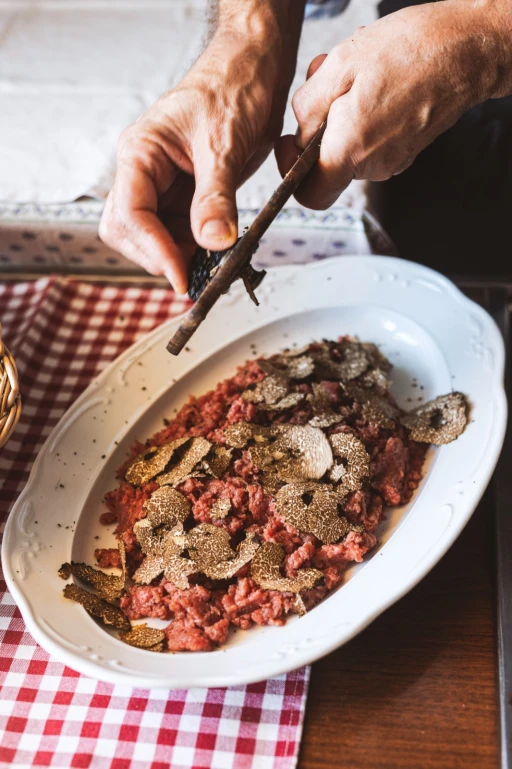
Creative people change the world
In the afternoon we visited the cultural workshop Serafina Quota. In the wonderfully authentic Borgata Casale, a small hamlet between Dogliani and Belvedere Langhe stands a stately country house that has called for new content for many years. The Cultural workshops and studios are housed here.
The rooms and workshops are open to like-minded people. Creative people who want to take a break from everyday life to live and work in unfamiliar surroundings for a while. In the cultural workshop, people come together to work, exhibit, network, and – last but not least – enjoy.
The Storage rooms are full of reclaimed materials. A printing press now stands in place of Piedmontese cows in the renovated stable. A darkroom fits perfectly into the analog rooms, and then there is the cozy kitchen with a wood-burning stove, a vegetable garden, and a pottery studio that might be coming soon. There is also lino printing and a music studio.
Yvonne Amann, is the mastermind behind the cultural association. She loves country life and creative people. She also firmly believes that good design – right after good music – can save the world. It is an exceptionally inspiring place, offering a truly unique opportunity to stay here and have these provisions readily accessible to you. You can work independently or learn how to use the equipment through workshops and Print Charles is always around to explain how to use the vintage printing press.
Monforte d’Alba,
There are many stunning hilltop villages in this area, we visited Monforte d’Alba, a beautiful historic village with a castle, surrounded by vineyards. Monforte d’Alba is an absolute foodies heaven, in this tiny village, there are 7 restaurants in the Michelin Guide of which two have a Michelin star. Additionally, there are many excellent wine bars, of which the Barolo Bar is a local favorite.
To visit the Barolo Bar, you walk down a narrow alley between the market square and the church. The modest space in front of the door is only big enough to fit a few narrow tables. The interior is divided into two rooms, so if you come in summer be sure to secure a seat on the opposite terrace next to the church portal. From here, the view of the old town of Monforte is fantastic. There is a weekly market every Monday, otherwise, it’s worthwhile doing your shopping in the late morning where you can sit down for lunch on the terrace of the bar.
Tip: It’s worth visiting the “Chiesa Parrocchiale Madonna della Neve a Monforte d’Alba” right next to the bar.
Felicin
With so many great restaurants in Monforte d’Alba, it might be hard to choose, but we knew exactly where we were going Felicin restaurant is an institution here in the area. Run by the same family for over 100 years, the interior has changed very little over the years. Another thing that has not changed is the quality of the food, it is well known for its excellent specialties from the Langhe region. Unfussy yet full of flavor and textures, Felicin’s classic cuisine never goes out of style. A few classics:
Tajarin Piedmontese’s iconic handmade pasta is rolled out and cut by a knife and made with organic fresh eggs (the number depends on the weather’s humidity and remains the restaurant's secret) and fresh flour by the millers from Mulino Sobrino in La Morra.
Vitello Tonnato Sliced cold veal and tuna sauce, one of the most popular dishes.
Cherasco
There are many well-known villages in this area, such as Barolo, La Morra, Monforte d'Alba, Neive: and Alba. We chose this morning a lesser-known village: Cherasco. An elegant and graceful Piedmontese town famous for the 'Baci': these are delicious chocolates made with dark chocolate and hazelnuts of the 'Gentile delle Langhe' variety.
We started this morning with a Caffè Marocchino [Mah-rohk-KEE-noh]. If soulmates could be drinks, this would be it. It originated in the northern Piedmont region and translates to “the little Moroccan.” It’s the ideal blend of espresso, a bit of cocoa powder, a small layer of foamed milk, and then some more cocoa.
There are some amazing Slow food shops around and these are the perfect souvenirs to take home as well as the famous Baci Chocolates, they are divine!
Aqua di Cherasco
We then met up with Stefania, the local pharmacist and chemist who focuses on fragrance production. She closed the pharmacy for a while and took us next door to her latest creation, a delightful little shop filled with home fragrances: Aqua di Cherasco.
Stefania has created these fragrances inspired by places in Cherasco. For example “Sacristy” a scent dedicated to the sanctuary of the Madonnina, or “Secret Garden”: a scent dedicated to the gardens of Cherasco. Stefania offers multi-sensory tours through Cherasco and takes you to the places these scents are dedicated to. Smelling the fragrances again gives them a whole new dimension. Stefania is still in the early stages of this project, but she has already gained significant recognition for what she has created. This multi-sensory experience is unique and the delicious home fragrances as well as Cherasco have been given a deeper meaning.
Bra, the slow food capital of the world
Carlo Petrini, the visionary founder of the Slow Food movement, is from Bra, and that in itself is reason enough to visit this town.
The slow food movement
In Italy in 1986 there was a revolt against the first McDonalds in Rome, which led to the Slow Food Movement. This movement aims to preserve the regional cuisine and traditional cooking methods and support local farming. People started to realize that tourism was not doing the food industry any favors, instead, it changed the way people consumed food. Large, chain-based restaurants pooped up with prefab food while taking away the profits from local, family-owned restaurants. The slow food movement worked to draw businesses back to traditional restaurants by using regionally sourced fresh ingredients, and home-cooked food with as goal to stimulate the local economies.
Osteria Boccondivino
If Bra is the birthplace of the Slow Food Movement, then Osteria Boccondivino is its inner sanctum. Also founded by Carlo Petrini, this restaurant is the perfect spot for lunch in one of the beautiful dining rooms or in the shaded courtyard outside. The restaurant is a lively and dynamic place where they are always looking for improvement and inspiration. They are closely connected to the nearby University of Gastronomic Sciences. Students gain and share experiences here and then of course there are the legendary graduation dinners.
Our lunch was simply divine with a special mention for the delicious, traditional Piemontese deserts:
Bonet: chocolate and amaretti pudding
Torta di Nocciole: Hazelnut cake made with the famous Piemonte hazelnuts (often considered the best hazelnuts in the world)
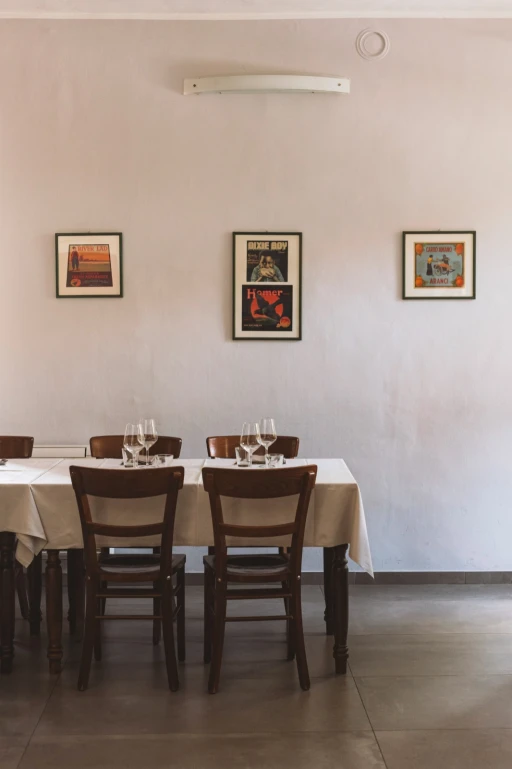
Slowfood HQ
The slow food movement headquarters are located next to the restaurant. Among the many things they do, they have also created the app “Osteria 2023”. When travelling in Italy this should be on everyone’s packing list. Although the app is in Italian, it is very easy to navigate even if you don’t speak the language. It basically indicates the nearest slow food restaurant wherever you are in Italy. Once a restaurant qualifies as a slow food restaurant they get the snail of approval (Logo of the slow food movement).
Caffe
Before heading back home we finish with one more coffee. Italy is renowned for its high-quality coffee culture. Even at the gas station along the motorway, you can get a good cup of coffee. However, never mention this when you visit Bottega delle Delizie. This is a very niche coffee place, making coffee has been made into a science here. They can and will not be rushed, preparing a good coffee takes time precision, and a lot of love.
To prepare a balanced and aromatically rich Espresso, they recommend that you let your coffee beans rest at least 3 weeks from the date of roasting and then grind it fresh just before extraction. Use only filtered water designed for coffee, the recommended hardness is 50/60 PPM (Parts per Million) of TDS (Total Dissolved Solids).
Temperature is also very important. If you use only roasted coffee in compliance with its native characteristics, they recommend a temperature of 95º C with a pressure of 9 Bar and use 17g of ground coffee for the perfect cup of coffee.
De highlights of our tour:
Places to Stay
The magical houses of Yvonne: Plinius No. 030, 033, 023 and 059
Plinius Little Gem: Hotel at Poderi Einaudi
Plinius Little Gem Hotel: Boutique Hotel in La Morra
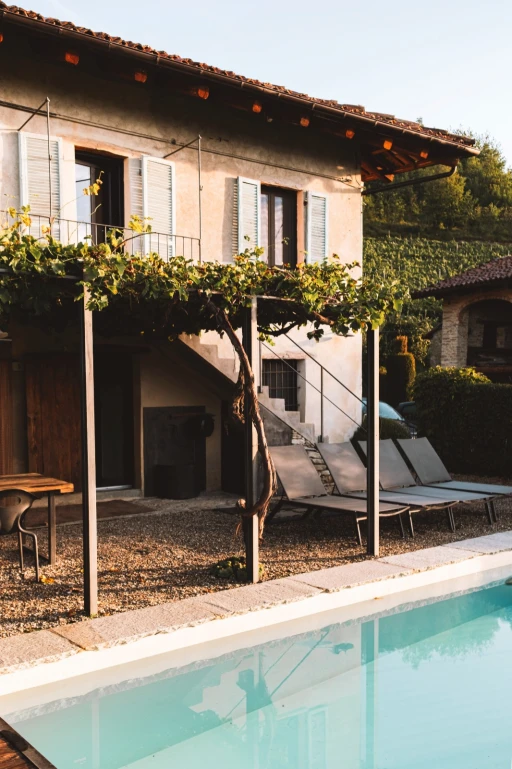
Activities
Vineyard hikes and bicycle rides: We often use the Komoot app, which will indicate the nearest trail close to your location, You can select but time/ level.
Poderi Enaudi: Guided tour of the cellar and tasting
Sensory walk: Aqua di Cherasco
Truffle hunt: You can inform them of the place where you are staying, and they will know the best, local truffle hunter in the area.
Cultural workshop Serafina Quota: Anyone who is interested can contact info@plinius.homes for more information.
Sleep
De magical house of Yvonne: Plinius No. 030, 033, 023 and 059 :
Yvonne's renovated holiday farmhouses are minimalist, yet very tastefully and warmly decorated. You can completely relax and recharge during your (culinary) vacation in Piedmont at the Serafina Houses. It is also definitely worth it to attend a Serafina Quota workshop with Yvonne, which is included with your stay in the houses.
Plinius Little Gem: Hotel at Poderi Einaudi
Plinius Little Gem: Boutique Hotel in La Morra
Eat
1. Osteria more e Machine - La Morra
Try the ravioli del plin here, accompanied by a glass of local wine. Via XX Settembre 18, La Morra
Unique trattoria in Piedmont, where you feel like you're in the sixties. You eat what is being served, but it's always good.
3. Felicin
Fantastic restaurant with regional dishes. On a sunny day, a terrace with a view over the vineyards is highly recommended.
4. Osteria Boccondivino
Sacred ground for the Slow Food movement and a restaurant where you always get delicious and honest food served
Wine
1. Le Vigne Bio, wineshop/enoteca
Enoteca, tasting room, and Osteria in one. A special place to learn more about and taste organic wines.
2. Barolo Bar: Monforte d’Alba
Popular bar among both locals and tourists. Enjoy an aperitivo on the terrace with a view over the village. Via Giuseppe Garibaldi 11, Monforte d'Alba
3. Podere Einaudi, Dogliani
The beautiful wine estate of the Einaudi family is where you can taste wine on-site. The cost for a tasting varies from €30 to €150 per person, but they do serve renowned names.
Apps
Osteria 2024: Slow food restaurants in Italy. The app is in Italian but very easy to navigate and it does give you the best slow food restaurants wherever you are in Italy.
Komoot: hiking and cycling trails near you.



